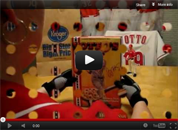Before You Vote for "Lack of LaRue"
Before you cast your vote for “Lack of LaRue” in the Red Hot Mama poll that you'll notice in the right sidebar, you might be interested in this tidbit. When Jason LaRue was traded to the Royals for a PTBNL, several people lauded the move for freeing up salary. LaRue made $5.45 million, they said, and dumping that obligation would more than pay for the first year of Alex Gonzalez's 3-year, $14 million contract.
However, this was based on initial reports that the Reds hadn't sent any cash to Kansas City. Later clarification indicated that there was cash involved, but didn't specify the amount. But in his Reds Insider column in the Cincinnati Enquirer this morning, John Fay reveals that the Reds are sending $3 million along with LaRue.
But for the sake of argument, let's say the Reds' payroll will be $70 million. The club already has $49.225 million committed to 11 players: Ken Griffey Jr. ($12.5 million), Adam Dunn ($10.5 million), Eric Milton ($9 million), Bronson Arroyo ($3.8 million), Gonzalez ($3.5 million), Rheal Cormier ($2.25 million), Stanton ($2 million), Ryan Freel ($1.7 million), Scott Hatteberg ($1.65 million), Javier Valentin ($1.325 million) and Juan Castro ($1 million).
Add the $3 million the Reds are paying toward the salary of the departed LaRue, and you're at $52.225 million.
Suddenly, shipping our long-time catcher to the breadbasket isn't doing such a great job at freeing up payroll. Saving less than $2.5 million? That will barely cover Rheal Cormier next season, let alone Gonzalez. Not to mention the dearth of John Deere hats we're going to suffer from now.



Tuesday, May 9, Reds vs. Nationals. Reds down 4-0 in the seventh, Belisle has one out and is working on Soriano, trying to get out of the inning so the Reds can bat and, hopefully, start a comeback. Let’s go to the tape:
“Here’s the pitch…strike three, Belisle fans Soriano…Wait, LaRue loses the handle, it’s a passed ball! There goes Soriano down to first, and…he’s safe! Holy cow!”
Nick Johnson then grounds out to first for what should have been the third out. But because of LaRue’s passed ball, Guillen comes to the plate. Back to the tape:
“Here’s the pitch to Guillen. High fly ball, deep center field! Back goes Freel. On the track…Looking up…It’s outta here! Guillen shouldn’t have even gotten to bat in this inning, but he hits a two-run homer, his second of the game, and it extends the Nationals’ lead to 6-0.”
That pretty much put an end to any hope for a Reds comeback.
Isolated incident? Unfortunately, no. In 680 major league games, LaRue has committed 68 passed balls, an average of one every ten games. That’s too many. The number one thing a good defensive catcher does is to keep the ball in front of him. That’s why they call the position CATCHER.
If you check his career lines in this regard it’s been bad year, good year, bad year, good year. This was a good year; heaven help the Royals next year, which figures to be a bad year.
Another thing a good catcher does is frame pitches. LaRue couldn’t frame a pitch to save his, uh, well, you get the idea. And why not? Because in order to do that, you have to properly set up and target the pitch. If you call for a pitch on the outside corner you set up behind the plate a few inches in that direction. Watch some tape of LaRue catching a game. He consistently fails to set a proper target.
Sorry for the rant, but every time I read somebody’s comments on the trade it seems to start out with something like, “Well, LaRue was a great defensive player, but…” – and I’m thankful I work at an airport and have an unlimited supply of airsickness bags at my disposal, because LaRue was not and is not a great defensive player. The reason so many people think that is because of radio and TV announcers overrating his throwing arm.
The fact that the Reds had to shell out a few million bucks just to dump him to the worst team in baseball in exchange for a minor leaguer is evidence that the rest of the teams in baseball weren’t fooled. LaRue to the Royals is addition by subtraction.
HMZ
Never a need to apologize for a rant, though I’m pretty sure I didn’t say anything in defense of LaRue’s defense. Not to say that I wouldn’t defend his defense, I just wasn’t getting into it in this post. This post is to say that trading LaRue was a rotten financial deal.
If you want to call it addition by subtraction, that’s your business, and I can get behind the idea that radio and tv announcers don’t necessarily know a good arm when they see one. But to say that this rotten financial deal is evidence that the other teams in baseball know better doesn’t pass the sniff test. Cincinnati fans alone have seen enough to know how little a clue baseball people often have about baseball players.
In fairness to LaRue, his propensity for giving up passed balls has improved, he does have an excellent arm, and his ability to get out from behind the plate is valuable. He’s not a great defensive player, but he’s easily above-average (and way, way better than what we’ve got). If he manages to put up a .740 OPS next year, the Reds will have lost the trade.
In Jason’s first full two years of catching he had 35 PB’s, he averaged around 110 games a year. In the next three years of full time catching, again around 110 games a year, he had 24 PB’s. I could see him improve each year I went to GABP which is all you can ask of anyone. Now if Dunn would follow a like progression in lowering his strikeouts I would be one happy camper.
I’m afraid LaRue was a “baseball guy”. I think he’s the first of his kind to be cast away by the Reds.
He was, however, tough as nails. That attribute might be missed, but it’s hard to quantify a value for said loss.
Don’t forget “hotter’n all get out,” another attribute that I’m sure to miss.
I’ve heard that he wears sweat well too. Not sure if that’s a baseball skill, but it sounds important.
And something I’m sure you’ll miss, Joel: he occasionally had an excellent moustache.